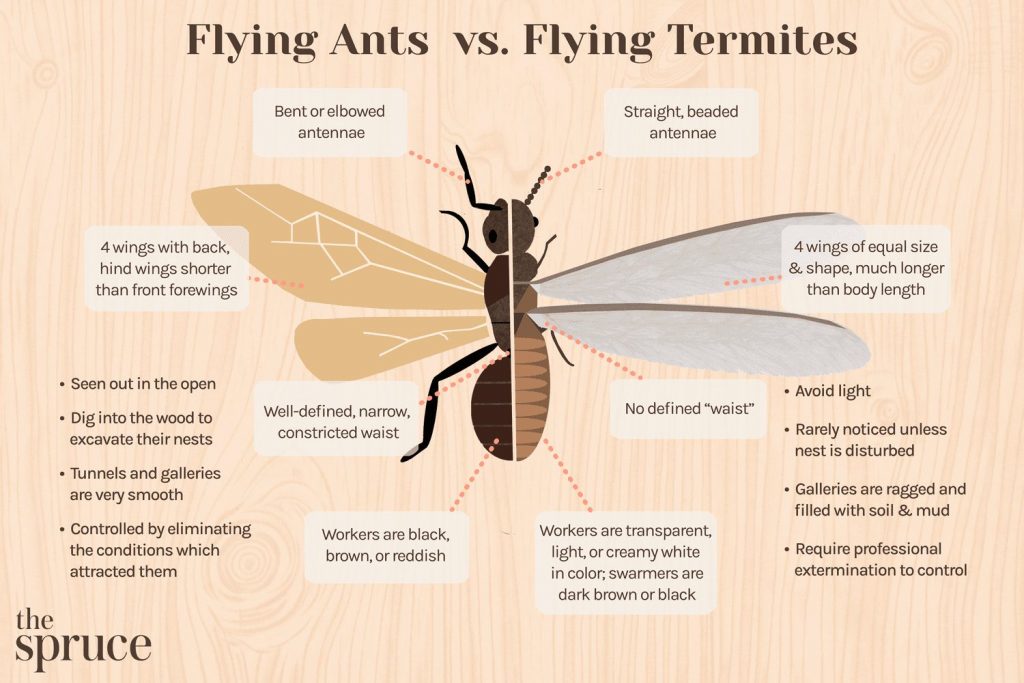Carpenter ants and termites are two of the most common household pests, but it can be difficult to tell them apart. In this article, we’ll discuss the key differences between carpenter ants and termites and how to identify them.
What are Termites?
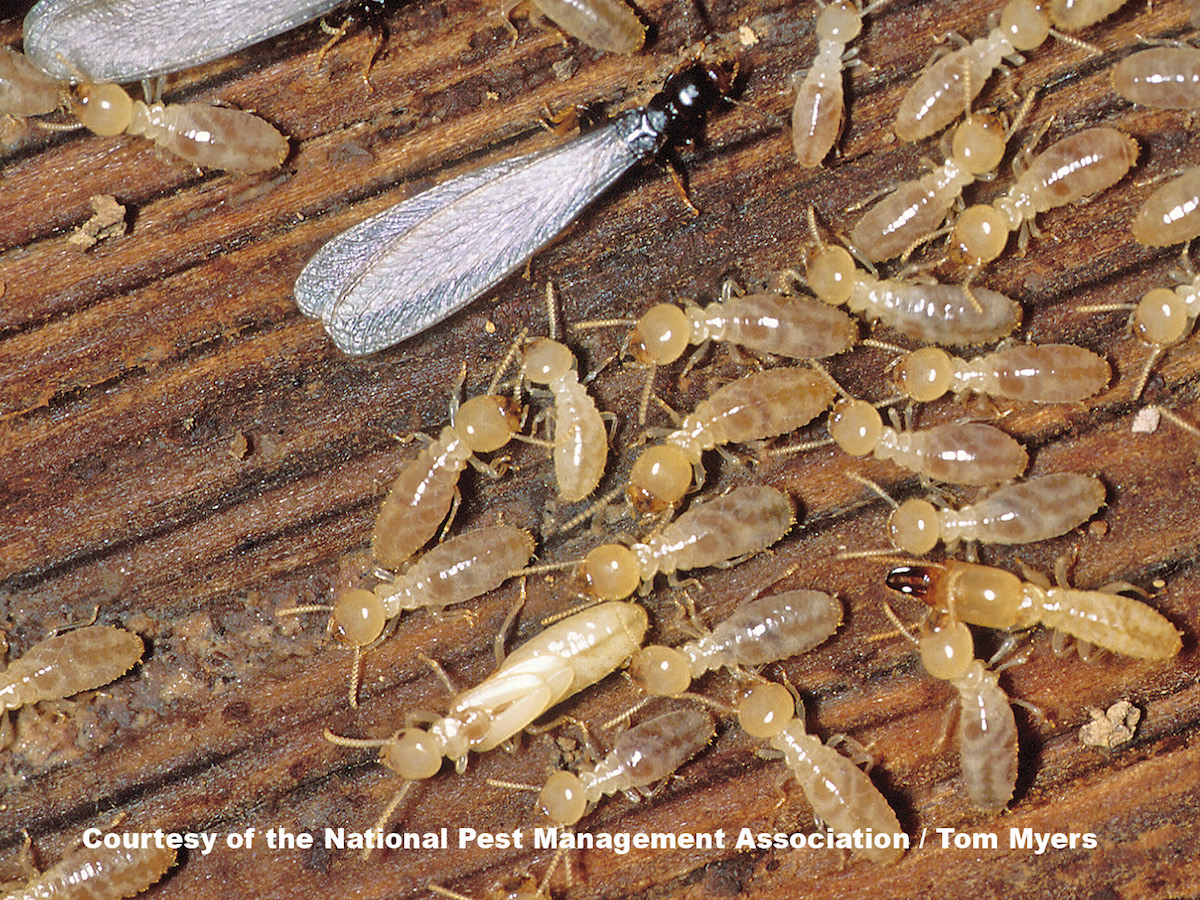
Termites are small, soft-bodied, social insects of the order Isoptera. They are usually found in warm climates, and feed on cellulose found in wood, soil, and other plant materials. Termites are known for their ability to cause extensive damage to buildings and other wooden structures, as they bore through wood, often undetected until it is too late. Unlike carpenter ants, termites feed on wood, not just digging through it. They have special enzymes in their saliva that allow them to break down cellulose, which is the main component of wood and other plant materials. Termites also have a unique method of digestion, which allows them to consume wood more efficiently. This method also leaves behind a distinctive mud-like material known as frass, which is a tell-tale sign of a termite infestation.
How do Termites Damage Wood?
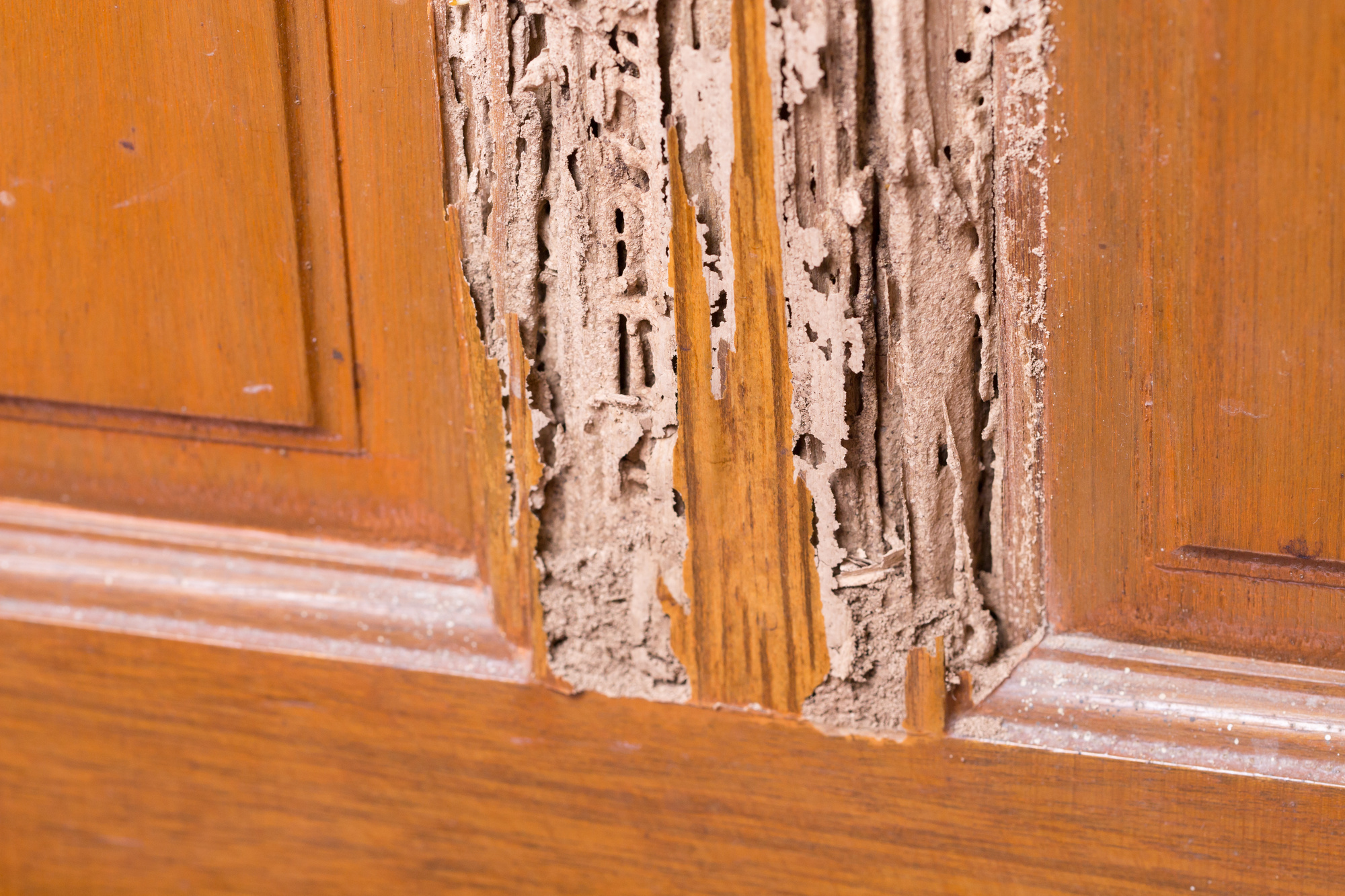
- Termites feed on wood and cellulose materials, such as paper, cardboard, and insulation.
- They can chew through wood and cause structural damage to buildings, furniture, and other items made of wood.
- Termites can enter homes through small cracks or openings in the foundation, walls, or floorboards.
- They can also enter through gaps in windows or doors that are not sealed properly.
- Once inside, they will begin to eat away at wood and will create galleries of tunnels and chambers as they feed.
- The damage they cause is not visible from the outside and can often go unnoticed until the damage has become extensive.
- Termites can cause extensive damage to the structure of a home, including weakening the foundation and walls, and can also cause damage to furniture and other items in the home.
- Termite damage can often be difficult and expensive to repair.
What are Carpenter Ants?
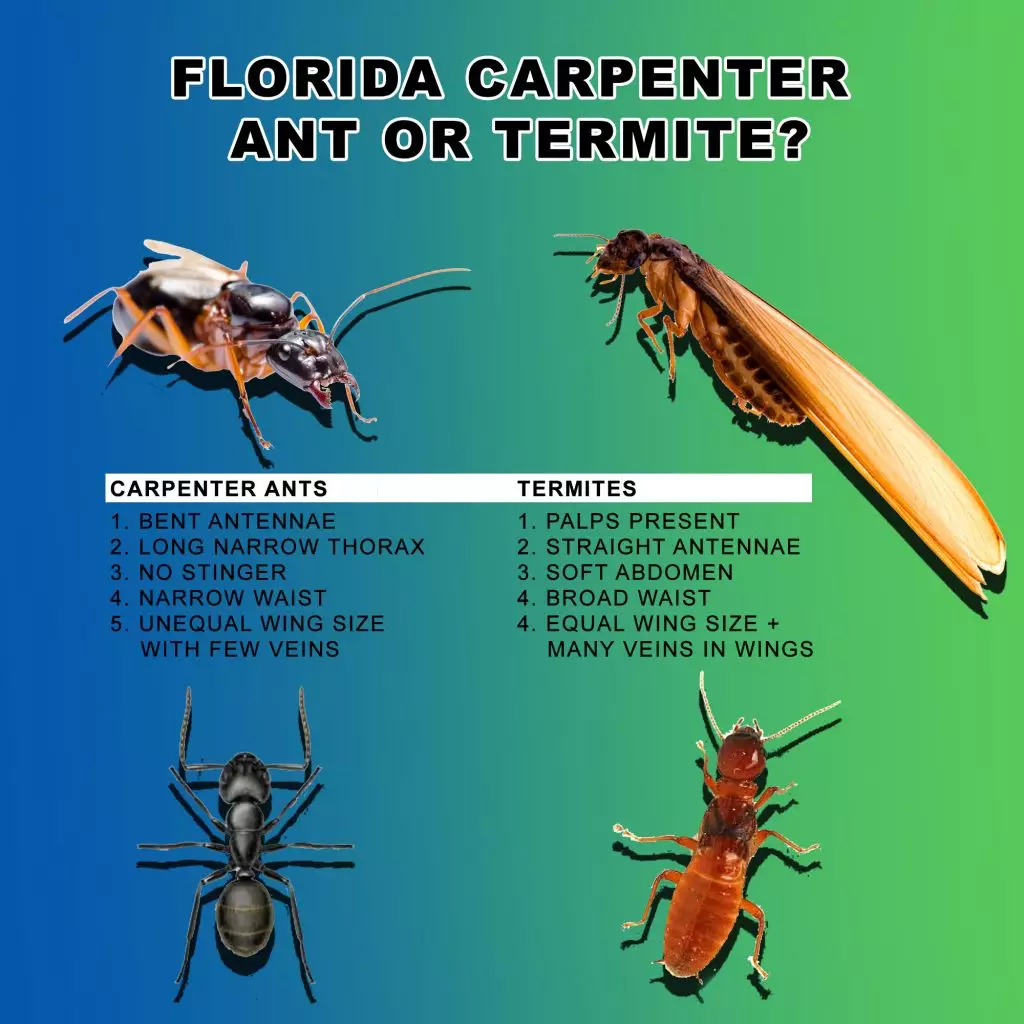
Carpenter ants are large, black ants that range in size from 6 mm to 13 mm. They are distinguished by their elbowed antennae, uneven thorax, and a single segmented petiole. Carpenter ants have strong mandibles used for cutting and excavating wood. They can be found in most parts of the United States and Canada.
Carpenter ants are omnivores and feed on plant and animal matter. Their diet includes fruits, other insects, and honeydew. They can also eat other small animals such as spiders and centipedes.
Carpenter ants live in colonies and build nests in wood. They prefer damp, decayed wood, but can also build nests in dry wood. Carpenter ants will excavate wood to form galleries, where they will live and raise their young.
| Carpenter Ants | Termites |
|---|---|
| Large, black ants | Small, white insects |
| Elbowed antennae | Straight antennae |
| Uneven thorax | Smooth thorax |
| Single segmented petiole | Two segmented petiole |
| Strong mandibles | Soft mandibles |
| Omnivores | Herbivores |
| Damp, decayed wood | Dry wood |
How do Carpenter Ants Damage Wood?
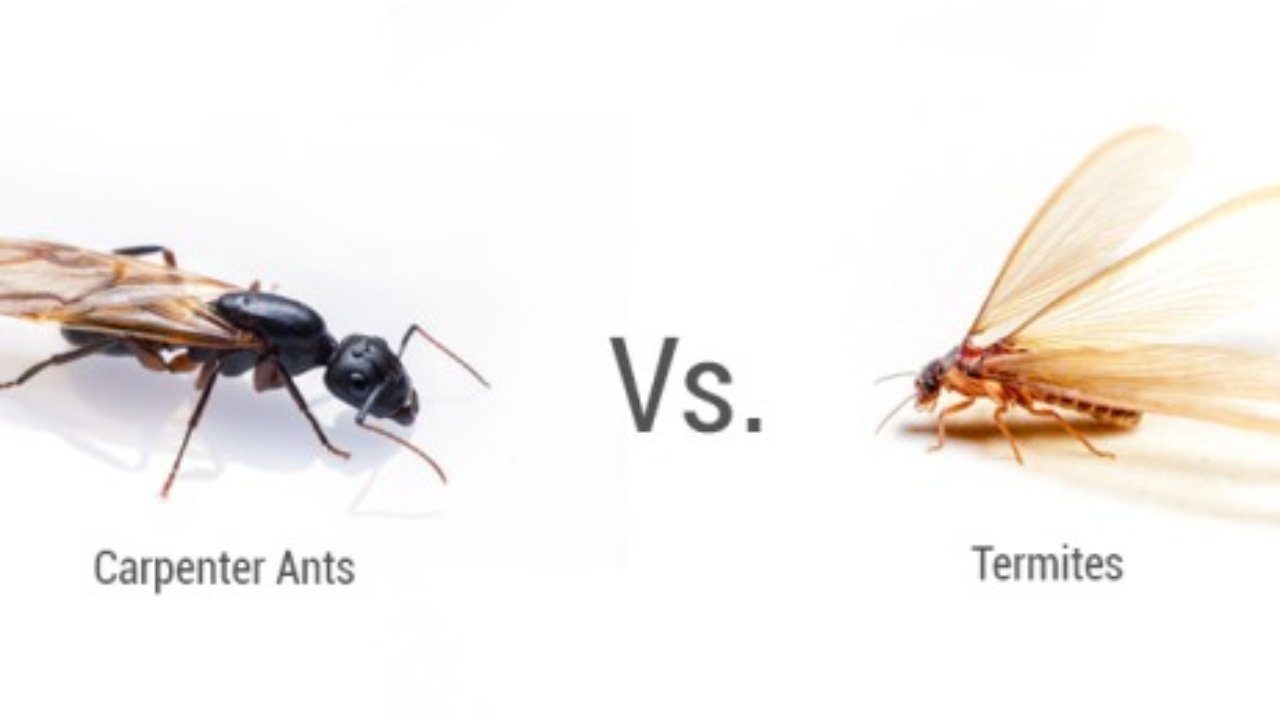
Carpenter ants are wood-destroying pests that cause extensive damage to wooden structures. Unlike termites, carpenter ants do not feed on wood; instead, they excavate galleries in wood to build their nests. These galleries are usually smooth and clean, with a sawdust-like material known as frass lining the entrance. Carpenter ants create galleries in both soft and hard woods, including structural components such as beams, joists, and studs. The galleries they create can weaken the structural integrity of the wood and, if left untreated, can cause significant damage to the structure.
Differences between Termites and Carpenter Ants
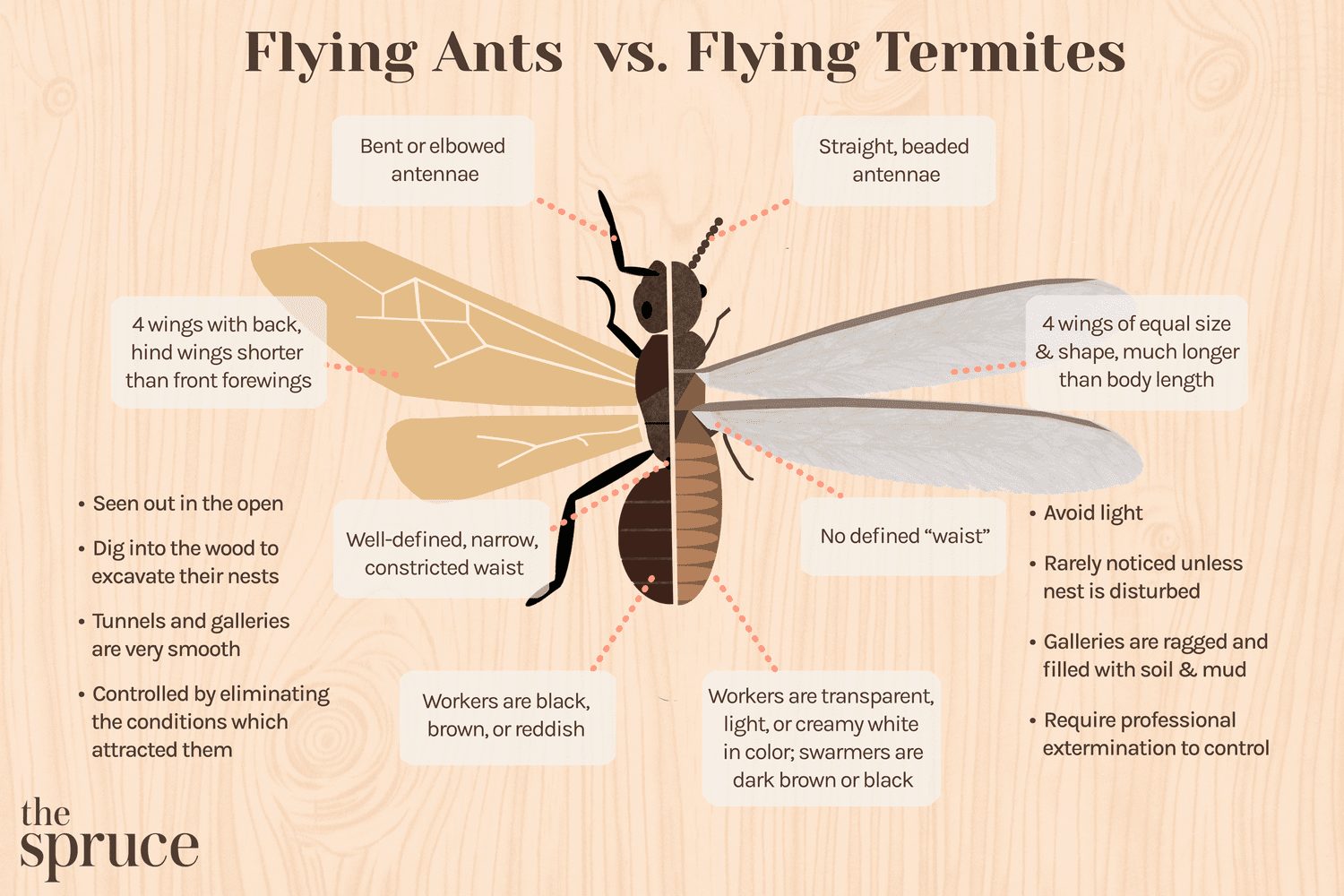
- Appearance: Termites are soft-bodied, white to pale brown in colour, and have straight antennae, while carpenter ants are dark brown to black in colour, have slightly bent antennae, and have a defined waist.
- Feeding Habits: Termites feed on wood and other cellulose-based materials, while carpenter ants feed on protein-based food sources.
- Damage: Termites cause more damage than carpenter ants, as they can consume wood and leave behind a network of underground tunnels. Carpenter ants, on the other hand, create shallow galleries in wood, but do not consume it.
- Habitat: Termites are usually found in moist, dark environments, while carpenter ants prefer dry, warm areas.
- Nests: Termites build mud tubes and mounds, while carpenter ants build nests in wood.
Signs of Infestation from Termites and Carpenter Ants
| Pest | Signs of Infestation |
|---|---|
| Termites |
|
| Carpenter Ants |
|
Prevention and Treatment of Infestation from Termites and Carpenter Ants
- Remove any sources of excess moisture from your home, as this will create a hospitable environment for termites and carpenter ants.
- Keep wood sources away from the house, such as firewood, logs, and other wooden items.
- Repair any leaky pipes or fixtures in your home to reduce moisture levels.
- Inspect your home regularly for signs of infestation, such as piles of sawdust or tunneling in the wood.
- Seal any cracks or openings in your foundation or walls that could be used by termites or carpenter ants to enter your home.
- Treat your home with a professional pest control company to eliminate any existing infestations.
- Apply insecticides or baits around the foundation of your home to prevent future infestations.
- Store firewood away from the home in a dry, covered area to prevent infestation.
Frequently Asked Questions
What is the difference between termites and carpenter ants?
Termites and carpenter ants are both wood-damaging pests, but they have some key differences. Termites feed on wood and other cellulose-based materials, while carpenter ants mainly remove wood as they build nests. Termites have a thick, white, soft body, whereas carpenter ants have a black, hard body with a narrow waist and bent antennae. Termites have straight antennae, while carpenter ants have elbowed antennae. Termites often form large colonies and do not typically forage for food, while carpenter ants may form smaller colonies and forage for food. Finally, termites often leave behind a powdery, sawdust-like residue, while carpenter ants leave small piles of wood shavings.
How do wood ants differ from termites?
Wood ants and termites are both social insects found in many parts of the world. However, they differ in several ways. Wood ants, or carpenter ants, feed on living and dead insects, other arthropods, sweet substances, and honeydew left by aphids and other sap-sucking insects. In contrast, termites feed on the cellulose found in wood, paper, and other materials. Wood ants build nests in rotting trees, stumps, or logs and in walls and attics of buildings, while termites construct nests in the soil. Wood ants have an elbow-shaped antennae, while termites have straight antennae. Furthermore, wood ants have a single node between the thorax and abdomen, while termites have a two-segmented waist.
Are Carpenter Ant and Termite Damage the Same?
No, carpenter ant and termite damage is not the same. While both are considered wood-destroying pests, their approach to damaging wood is quite different. Carpenter ants use their mandibles to excavate galleries and nest sites in wood, and consume wood for nutrition, whereas termites consume wood for sustenance and use their saliva and feces to break down cellulose for digestion. As a result, carpenter ant damage is characterized by clean, dry galleries and frass (wood shavings) while termite damage is characterized by mud tubes, swarms, and damage that has a “honeycombed” appearance.
Do Ants Eat Wood Like Termites?
No, ants do not eat wood like termites. Termites consume wood, breaking it down into cellulose and turning it into food, while ants are primarily scavengers, foraging for food and bringing it back to their nests. Carpenter ants, however, do cause significant damage to wood structures due to their nesting habits. As their name implies, carpenter ants bore into wood to make tunnels and galleries for nesting. This can weaken the structural integrity of the wood, threatening the stability of the entire structure.
Are Carpenter Ants the Same as Termites?
No, carpenter ants and termites are different species, but they both cause similar damage to wood in buildings. Carpenter ants excavate galleries in wood, whereas termites actually eat wood. Carpenter ants are large and black, while termites are smaller and pale. Carpenter ants feed on live and dead insects, honeydew, and other sweet foods, while termites feed on cellulose found in wood and other materials.
Conclusion
Carpenter ants and termites are both wood-destroying pests, but their differences are important to note when determining the best way to protect your home. Carpenter ants are larger and have black or red coloring, while termites are smaller and have a pale, creamy color. Carpenter ants do not consume wood, but instead hollow it out to create tunnels and galleries; termites, on the other hand, actually consume the wood. Though both are serious pests, carpenter ants can be easier to manage due to their larger size and slower reproductive rate.

